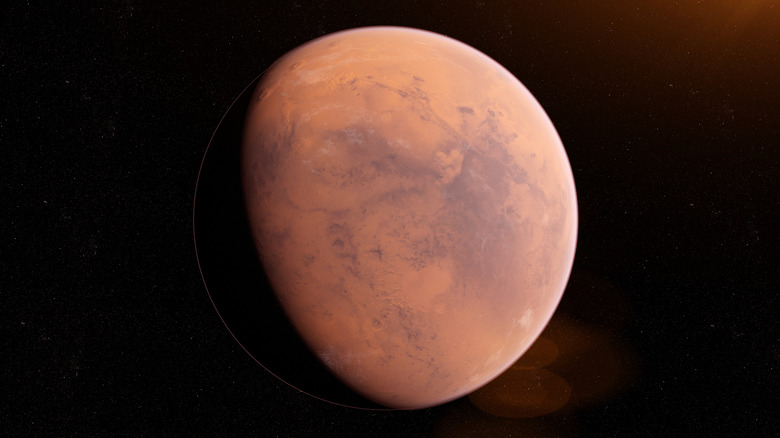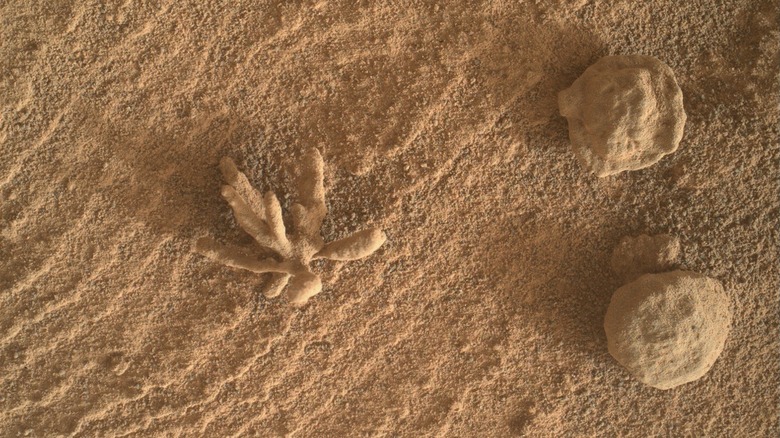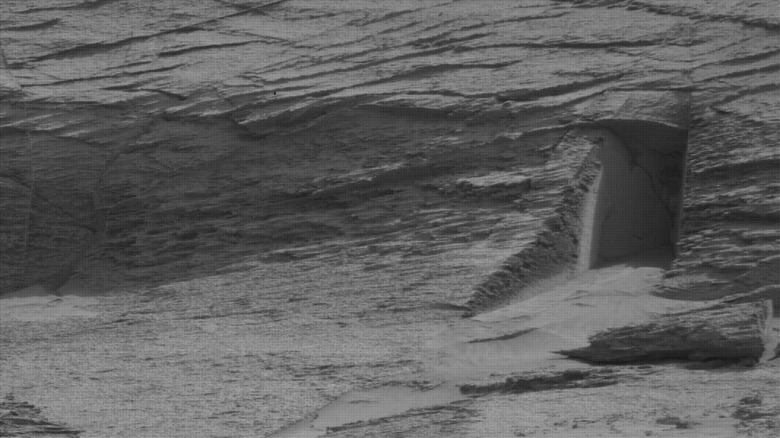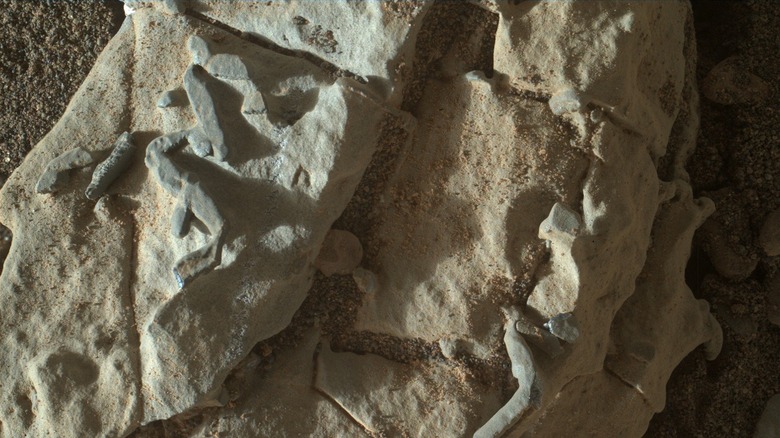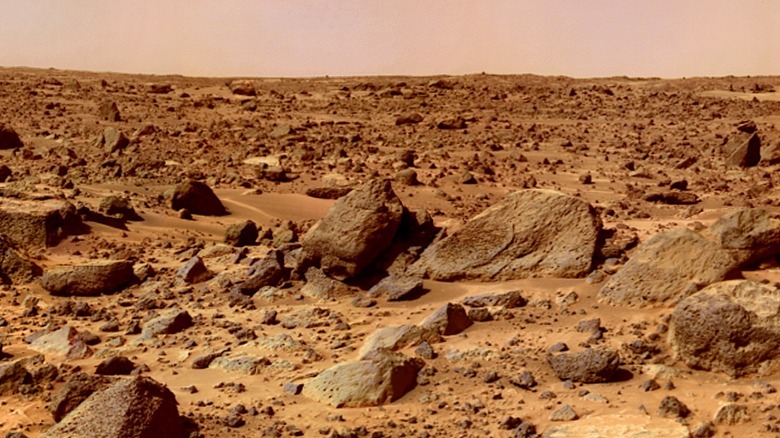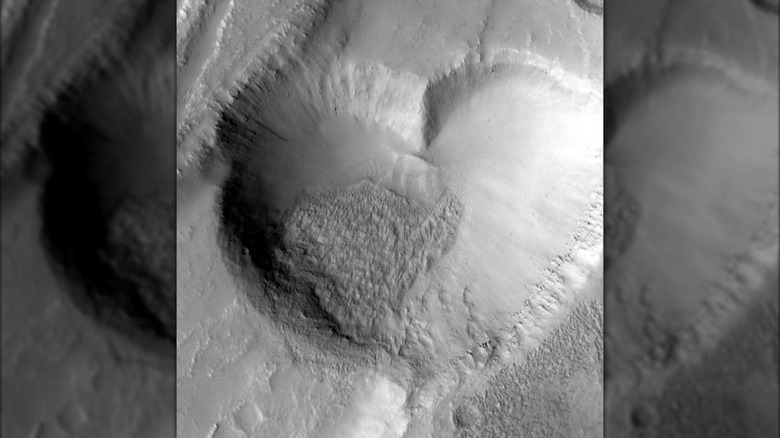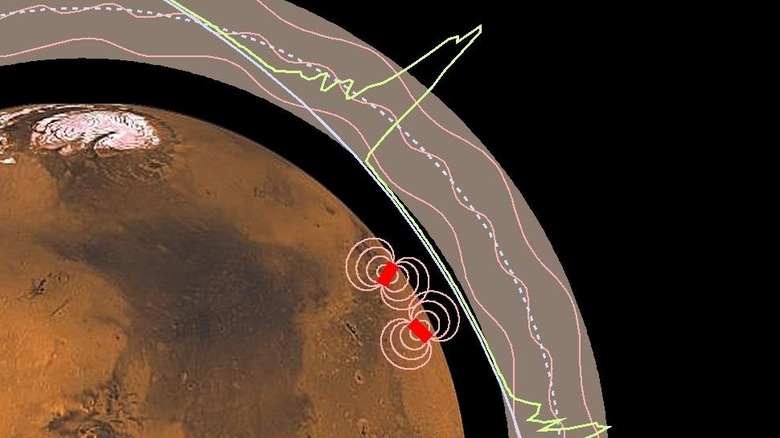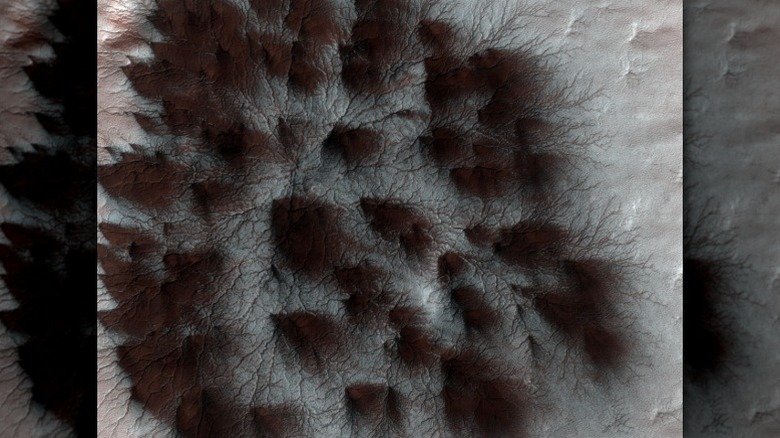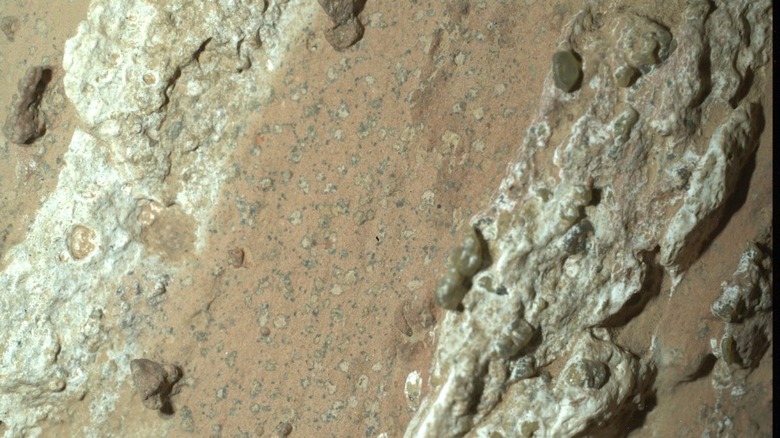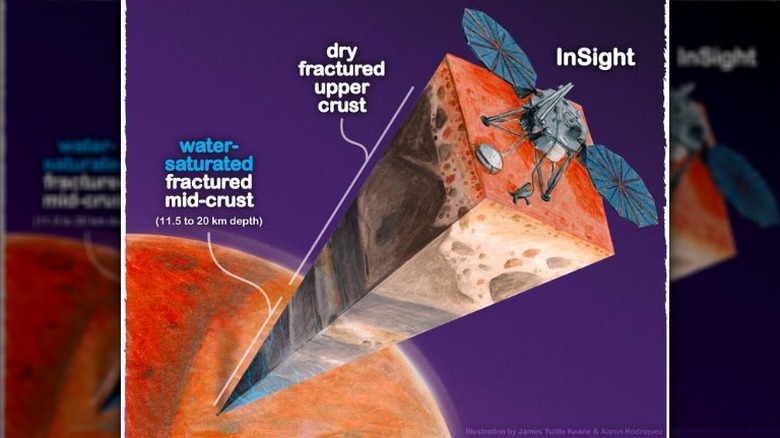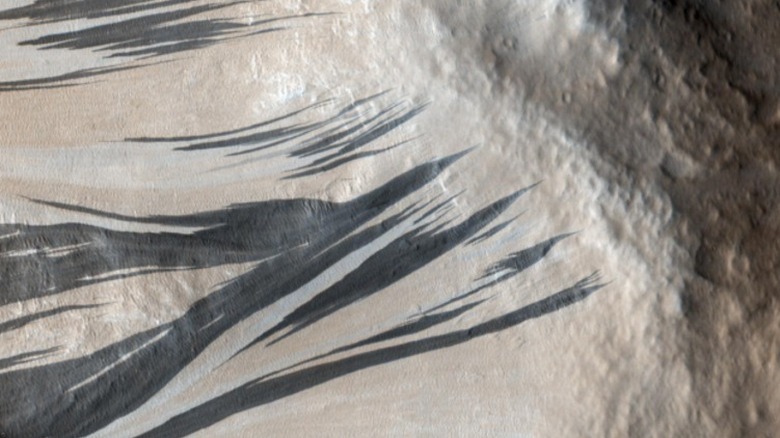13 Strange Things Humans Discovered On Mars
Mars may be one of our rocky sibling planets that has many things in common with Earth, but it's also full of mysteries that make it truly unique. NASA and other international space programs are uncovering new discoveries regularly; some that line up with what we've expected, and some that are truly out of this world — no pun intended. Currently, MAVEN, Odyssey, Reconnaissance Orbiter, Perseverance, and Curiosity are finding some seriously cool things on Mars, leaving us to wonder both what we'll find next and what it can tell us about our past.
That's why we've rounded up 13 of the most interesting things we've found on Mars that made us do a double take. We'll talk about how we've found it, why it's so perplexing, and what it might tell us about how Mars endures. The more we learn now, the better we can understand the universe and potentially prepare us for human-manned missions to Mars and beyond.
Tiny Martian flowers
If you're a gardener, then you may be excited to hear that we've found "flowers" on Mars. Well, sort of. On February 24, 2022, the Mars rover Curiosity found tiny mineral formations in Gale Crater that resemble a piece of coral or a floral bloom. While it was a little late for Valentine's Day here on Earth, this belated gift showed scientists a glimpse into Mars' past when liquid water flowed freely through conduits on the planet's surface, leaving its mineral deposits behind.
According to NASA, this mineral "flower" and its round companions on the right are smaller than a penny, yet reveal so much. These mineralized discoveries help us understand how rich the mineral content of Mars' water used to be and the way it moved in and through rocks on the surface. However, they're not the only deposits we've found; Opportunity noticed a cluster of small spherical deposits in 2004 that have since been lovingly nicknamed the "blueberries."
A doorway to another realm?
On May 7, 2022, Curiosity snapped an image while exploring the Greenheugh Pediment that looked straight out of a sci-fi novel. The image was monochrome and a little low resolution, which only added to the mystique of what it captured: An almost perfect rectangular shape in the rock that looked like a doorway into the planet. Unfortunately, it wasn't a mysterious portal into the unknown — just a leftover formation caused by natural erosion.
While it might make you give this explanation the side eye, there are a few facts that tell us there's more — or less — than meets the eye. For one, the rectangle is less than 3 feet high so, unless it's Alice in Wonderland or full of tiny Martian green men, it's unlikely anything's fitting through that door. What's more likely, and admittedly less tantalizing, is that a boulder gave out under its immense weight and collapsed on itself, creating this door-like shape along the natural fractures which you can see climbing up the right hand side of the door's "frame." In the foreground on the right you can also see chunks of rock lying on their side, most likely casualties from the collapse that were originally where the "door" is now.
Mineral growths that look like animal track fossils
On January 2, 2018, Curiosity took a picture near Mount Sharp that caused a ton of controversy, and probably a ton of headaches for NASA's PR team. These tiny tubelike structures are only about the size of a grain of rice, yet have had their meaning blown out to massive proportion, to the point that some believe they're fossilized burrowing tracks showing the red planet once sustained life. The truth is a little less sexy, though, as they're simply crystallized remnants of minerals that were once carried in Martian waters.
However, scientists say they can't definitively rule out either argument yet. For one, Curiosity doesn't have the sensitive tools necessary to probe these "tracks." For another, it's incredibly difficult to make that differentiation here on Earth, nevermind a remote planet 140 million miles away. But, since we've found more ample evidence of water than life, the Curiosity team feels it's better to err on the side of caution than letting our imaginations run wild.
Two tornadoes in a fight to the death
Swirling towers of air, known as "dust devils" are a common sight on Mars for the rovers, but on January 25, 2025, Perseverance saw something truly spectacular. On Jezero Crater near Witch Hazel Hill, it captured a short video showing not one, but two dust devils in a fight to the death. In the short recording, scientists watched as the largest tornado, clocking in at 210 feet, completely overtook and consumed its smaller rival, which stood a diminutive 15 feet. All it needed was a David Attenborough narration to make it complete, but alas, he's yet to cover the red planet's acts of aggression. But, in true nature documentary style, you don't need to pity the smaller devil for long, as it's likely the larger met its eventual end, too.
We've known about dust devils since the 1970's when NASA's Viking orbiters first shot footage of these swirling tunnels of air and dirt. We've captured their sounds, had one pass over a lander, and even saw a cluster of devils moving across Jezero Crater's floor, like a swarm of really tall, terrifying bees. These whirlwinds form as warm air rises from the planet's surface. As it meets with the cooler air higher in the atmosphere, the warm air begins to swirl and pick up surface dust, creating a wind column that's sort of like our planet's sandstorms, and crawl across Mars' terrain in 10-minute increments.
The floating St. Pauls Bay rock that looks like a cluster of spider eggs
On the slopes of Witch Hazel Hill at a spot known as Broom Hill, Perseverance sat, taking in the sights. On March 13, 2025, it pointed its Mastcam-Z camera at a rock called St. Pauls Bay, and saw something strange. While all the rocks surrounding it were tawny and flat, St. Pauls Bay was gray and covered in globules. Not only did it look like an anomaly against its neighbors, but some of the globules even looked like they had pinholes. Could this be a spider egg colony from Mars' ancient past? Turns out, no, it's more likely a rock that's had a history of being eroded by water and covered in sediment.
Despite St. Pauls Bay being more an ancient geological artifact than spider nursery, it's still something of a mystery to scientists. We're not sure how it got to its current resting place but know it's probably a long way from home, judging by the smooth texture and brown coloring of its rocky land mates. Consequently, St. Pauls Bay has been designated a "float rock," meaning it's origin is currently unknown, as if it somehow floated to its nesting spot on Broom Hill.
A Valentine from the Martian terrain?
Don't worry, Mars didn't forget you on Valentine's Day — in fact, it's got a heart-shaped formation on its surface to show just how much it cares. In June 1999, the Mars Global Surveyor (MGS) captured this love note from the red planet on the eastern flank of the Alba Patera volcano – a 1.4 mile-wide pit known as a "graben." This heartthrob of a graben was actually caused by a relationship, but it's not a love story. Instead, it's the relationship between lava flow, fault lines, and bedrock movement.
Grabens form when either tectonic forces move the bedrock or molten rock rises from deep inside the planet and reaches just under the surface. The surface collapses abruptly along fault lines, creating pits surrounded by sharp, straight cliffs. Also, as a little fun fact: MGS' history and findings are a treasure trove for those who love anthropomorphism. Not only did it give us the heart-shaped pit, but we also know about the Happy Face Crater because of it. See how much Mars likes us? It's baked right into the bedrock!
Magnetic anomalies that are 10 times Earth's and may be from fossils
Earth has a magnetic field surrounding it that's generated by the molten iron-nickel core that protects Earth from being affected by solar winds. Mars also used to have a magnetic field, but it shut down billions of years ago, and scientists haven't nailed down the exact reason why. So, you'd think that a magnetic field that's been MIA for so long wouldn't have many remnants — except it does. In 2020, NASA's InSight spacecraft found patches around its landing site that still remain of the bygone magnetic field. What's even weirder is that these magnetic patches are 10 times larger than any area we've found on our planet. Oh, and did we mention that they can fluctuate in strength and frequency daily, will pulse around midnight, and we're really not sure why? Yeah, that too.
Previously, we knew there were a few magnetic blips around the planet, but only monitored them from satellites about 150 kilometers up, so our understanding was rudimentary at best. Once InSight landed, though, we were able to hit one of these patches and use precise magnetic sensors to discover what was going on, sort of like putting the planet through an MRI machine. What scientists have gleaned from InSight's data is that the patches are caused by magnetic rocks buried deep in Mars' crust that are at least 3.9 billion years old. Now that we know the source of these patches, we can fine tune our understanding of Mars' history and how it might've lost its protective shield.
Giant fossilized spiders
While Mars has similarities to Earth, it's still chocked full of unique quirks that we haven't found here. Take, for example, the "spiders" we first noticed in 2003. These long, branchy formations can span half a mile long and contain hundreds of "legs." Are these giant fossils of a spider world long since passed? Unfortunately — or fortunately — no, but they do leave scientists in awe, nonetheless.
These formations are called araneiform terrain and tend to form in clusters, giving Mars' surface a dappled or wrinkled look. The current leading theory is that these are created with carbon dioxide ice in a process known as the Kieffer Model. Sadly, carbon dioxide ice isn't something that forms on Earth naturally, so scientists were left with nothing but their best guesses for the past 20 or so years. However, in 2024, researchers at the Jet Propulsion Laboratory at the California Institute of Technology were able to successfully create C02 ice in a lab, unlocking the key piece we needed to begin testing if the Kieffer Model held true.
A weird way for water to escape Mars
We know that Mars once had liquid water on its surface, but where did it all go? Sure, we can point to the loss of Mars' magnetic field, but how does magnetism prevent water from escaping, and, more importantly, is there some other mechanism we're missing behind this? For years, the missing lakes, rivers, and oceans were like a murder mystery novel on a planetary scale. In 2014, NASA's Mars Atmosphere and Volatile EvolutioN (MAVEN) orbiter revealed the process that stripped Mars of its atmosphere and liquid water: sputtering.
As Shannon Curry, the principal investigator of MAVEN explained it, sputtering is "like doing a cannonball in a pool. The cannonball, in this case, is the heavy ions crashing into the atmosphere really fast and splashing neutral atoms and molecules out" (via NASA). Before MAVEN, we had an idea that this was going on, but it wasn't until the orbiter landed that we were able to observe it in real time. Confirming the process might seem moot as it's already too late to get that water back, but seeing sputtering happen can give us insight into how such a massive amount of H20 and thick atmosphere could vanish, and the implications that has for turning a potentially habitable planet inhospitable to life.
Leopard spots that could be signs of life
On July 18, 2024, NASA's Perseverance rover captured this image of a rock known as "Cheyava Falls." At first, Cheyava Falls isn't particularly impressive; it's only about 3 feet by 2 feet and its reddish hue (caused by hematite) is streaked with white calcium sulfate veins — all things we've seen before. Yet, when scientists looked closer, they found something truly exciting: white patches that are surrounded by black rings, resembling leopard spots. These rings are tiny, only around 1 millimeter, yet they could be the signs we're looking for of life on Mars.
The reason these leopard spots could be evidence of life is because of a process we see occurring here on Earth. Here, hematite also begins with a reddish hue thanks to its iron oxide content. Occasionally, a chemical reaction happens where energy is released, causing spots of the hematite turn white with black halos made of iron and phosphate. That energy then becomes a food source for earthling microbes — could it have done the same for Martian ones, too? NASA used one of Perseverance's instrument suites known as SHERLOC to investigate further and were stunned to find carbon-based molecules on the rock, which are the building blocks of life. Is this the smoking gun we need to prove life existed on Mars? No, but it's it's tantalizingly close.
Cheyava Falls has even more mysteries to solve. See those green blobs on the right side of the image? Those are olivine crystals, which form from lava flows. So, which came first, the olivine or the molecules, and what does that timeline tell us about what happened to Mars? Maybe it's time to call Hercule Poirot.
An ocean so big it could coat Mars with water 1 mile deep
In 2024, NASA's InSight lander used seismic data to discover that Mars currently has a massive reservoir 7 to 13 miles down that's filled with water. NASA believes there's so much water under the mid-crust that it could drench the entire planet with water 1 mile deep. While finding a massive water reservoir is exciting in itself, scientists are particularly tickled because it could be a place where we find definitive signs, or even current examples, of Martian life.
While we haven't definitively looked into the reservoir to confirm it, mathematical models we use on Earth to find aquifers and oil deposits seem to work on Mars, too. One reason that scientists believe life could still exist there is due to what we see on Earth; our deepest ocean trenches were previously thought too inhospitable, yet we find new creatures nearly every time we look. Could the same be true for Mars? The problem is we may not know any time soon due to the depth of rock we'd need to drill down to investigate. Right now, the deepest hole we've ever dug on Earth is 7.6 miles, and that's without needing to import giant, heavy drills from another planet. NASA originally planned to try, nonetheless, in 2026, but budget cuts have pushed this back to 2040. However, NASA is hoping they can speed the timeline up by soliciting proposals from private companies.
The iconic face on Mars
Back on July 25, 1976, while looking for the best spot to land its sibling spacecraft, NASA's Viking 1 Orbiter captured what could be the first ever Martian selfie. This eerie image seems to depict a face staring right back at Viking 1. Could it be ruins of a statue from a bygone Martian species? Sadly, no; it's just our imaginations.
The face is actually a rock formation that's approximately 1 mile wide. Due to natural erosions and the angle of the sun hitting it, the formation gives the appearance of a human-like face. But this face is less an ancient artifact and more an example of pareidolia, a potential quirk of evolution where we perceive faces in inanimate objects. This was probably pretty useful for our ancestors to avoid ambushes from warring neighbors or hungry predators, but now just makes us think Mars is keeping just as close an eye on us as were are on it.
Mysterious black streaks that aren't caused by water
What you're seeing is not a painting or brush strokes, but actual markings on the Martian surface. First spotted by the Viking 1 Orbiter in the 1970's, these streaks were found on the slopes of Acheron Fossae and are hundreds of feet long. Yet it took two more decades before we could determine what they are and why they're there. These streaks, known as slope streaks and recurring slope lineaea (RSLs), are temporary discolorations on Mars that pop up from seismic activity, meteorite impacts, or just the wind.
Previously, scientists believed these discolorations were caused by water under the surface, darkening the topsoil. But in 2025, researchers used AI to analyze these streaks and found that there weren't any signs of water, but instead were formed by dry processes. What's most likely happening is that a sudden shift in layers of ultrafine dust move down a slope, sort of like an avalanche. The top layer of dust, bleached by the sun, gets covered by layers that were previously underneath and darker. The best evidence we have is that these occur suddenly and have a lifespan of years or decades for slope streaks, and a few months for RSLs. Though temporary and overall, insignificant to the Martian surface, these things are substantial, moving the equivalent of several global dust storms each time.
